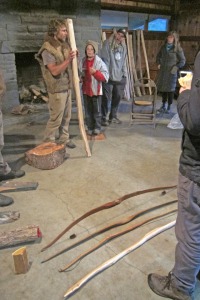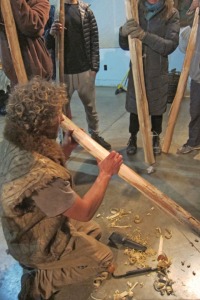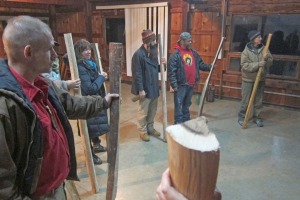my adventures at the two and a half day Bow Making Workshop at
Primitive Pursuits in upstate Arnot Forest during prime fall colors…
By Elska á Fjárfella of the Dominion of Myrkfaelinn.
When my hubbie decided he needed a better bow, he teamed up with
Edward of Delftwood to make a longbow from a premade bowstave. It took
him about six trips to Syracuse to get her done, and the bow he made is
an absolutely gorgeous contrasting color triple layer laminate with a
narrow “D” profile, made with plausible period materials and techniques.
And while laminating is a period technique (one only has to think of
the short, curved horse bow of the Mongol hordes) it’s not what came to
my mind when he talked about making a longbow. I’d thought of stone age
bows… Norse longbows… the incredible English longbows…
Reading up on the subject I quickly realized that what I like are
self bows made from one piece of wood, especially ones with character
(also called flaws). I could not find anyone to help learn about making
self bows, but fortunately, we live in an area with an active primitive
skills group of people (or Ithaca hippies, and do they look the part…).
As part of the Primitive Pursuits outdoor classroom, which specializes
in kid’s summer camps and after school programs but also has occasional
adult weekend workshops, once a year a Bow Making Workshop is offered
right here in town! And this year I decided to take the plunge…
With just a couple of common tools like a rasp, a knife and an axe,
and the abundance of his surroundings any person could, and can, make a
bow strong enough to take a deer. Actually, a metal rasp, knife and axe
is not even necessary, as one of our teachers demonstrated: he’d made a
bow with a stone axe and a flint scraper he’d made himself, as well as
creek sand as both file and sanding paper and it was completely
indistinguishable from the bows made using modern tools! Like Europe,
the American northeast has abundant hardwood forests with many suitable
trees, and making a bow suitable to hunt from locally harvested
materials is not out of our reach at all, even for us modern people!
First things first. We started the workshop with a sing-along to
honor the trees and say thanks. Not something I am used to, but nice in a
graceful kind of way. Then our two instructors introduced themselves:
Justin, barefooted and wearing an inside out sheepskin vest and Sean,
also barefooted and pledged to eat and work from and with local
materials only (he had a smoked squirrel for lunch). And while normally
feeling a bit out of norm as homesteaders etc, here I was likely one of
the more normal ones of the dozen and a half students! I felt right at
home…
Then we got right into bow making. As the bones of a bow is the wood,
good care needs to be taken to find a suitable log. As a general rule,
dense hardwoods like hickory, maple, oak, ash, and elm make good bows.
Conifers like pine do not, and softwoods like willow and basswood do not
either. Of course, the exception to this rule is yew, which is a low
density conifer and makes awesome bows. But it also needs fairly
specific strategies to work well with and is therefore not recommended
for the beginner.
Next up is the quality of the wood. Of course, ideal would be a
perfectly straight 6 to 7 foot, knot free trunk to be split into log
staves. But who’s got one of those… Making a bow is much more forgiving
that I expected and if reasonable care is taken in having a mostly
straight, mostly knot free log, apparently it will be fine. What is to
be avoided are twist and bends, especially for the beginner. A little
twist could be worked around, and a reflex or deflex bend could be
removed with heat, but these are more advanced techniques. Know your
limitations and keep looking to find a log to go with your comfort
level.
Our logs were cut between 6-7 feet (to fit the instructor’s truck
bed). A 4-6” diameter log could be split in half for two staves, using a
wedge, a mallet and some splitting wedges to keep the split going. When
it is split wood glue is put on the ends. Paint and beeswax works as
well, the advantage of wood glue being that it also works under tension
(it’s stretchy) and can sometimes prevent cracks that might otherwise
have happened anyway. The logs are dried in a cool dry place, like a
garage or basement. Whatever you do, stay away from the hot woodstove!
About half of the split logs the students could choose from had the
bark already removed as they were harvested in the summer, which was
very convenient. Removing the bark facilitates drying and also prevents
bark beetles from taking up home and destroying the potential stave.
Some people advise getting winter wood as the wood is driest that time
of year, others advise getting summer wood as the bark peels off easily.
The grain of the wood gives a bow its strength and flexibility, but
only if the back is one continuous growth ring from top to bottom. With
the types of trees mentioned, the wood right below the bark is the wood
used for making a bow, and baring the growth ring is easy if the bark is
loose and can be peeled right off. The exceptions are locust and osage
orange, where the outer sapwood needs to be removed and only the inner
core is used. If the bark is not loose, it can also be carefully peeled
first with a drawknife and finished with a scraping knife. Using a
drawknife is an acquired skill, so practice first on some scrap wood
until you get a feel for what’s happening. Whichever way you choose,
always make sure to peel away from knots so as not to violate the grain
curving around imperfections. Grain does not tend to go straight, so
keep a close eye on what’s going on and always, always follow the
‘yellow brick’ grain.
To be continued tomorrow…..
https://aethelmearcgazette.com/2016/11/13/from-split-log-to-bow-stave-day-one/




No comments:
Post a Comment